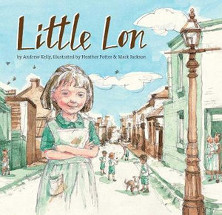Little Lon by Andrew Kelly

Illus. by Heather Potter and Mark Jackson. Wild Dog, 2020. ISBN:
9781742035970.
(Age: 5+) Highly recommended. When a new development loomed to knock
down a now run down area of Melbourne to make way for the
Commonwealth Building in 1988, an archaeological dig was initiated
to record and preserve mementoes of the lives of people who lived in
the back lanes of the inner city, lives rarely documented by
historians, overlooked by the builders of memorials, statues and
plaques that dot our landscape.
It is these lives that Kelly reveals in Little Lon. Just as the
illustrators, Potter and Jackson, preserve the buildings in their
beautiful drawings, so Kelly preserves the lives of the
ordinary people who lived there using interviews and
observation. And what a range for younger readers to ponder: the
Syrian family living above their shop, the boot makers from Lebanon,
the watchmaker in Cumberland Place, the Chinese cabinetmakers, the
Italians who made fairy floss for Queen Victoria Markets, the
Hungarian man who sold chestnuts from his cart. During the day Marie
went to the local St Patrick's Primary, reminded to wash her hands
when she arrived at school. Each Saturday the family went to the
City Baths for a slipper bath and on Sunday Mum took her roast to be
cooked by a restaurant in Exhibition Street, ready to be picked up
after church.
The details of the lives lived in these street will amuse and inform
younger readers, making them reflect on the changes in lives through
the generations, and see how different things were for those who
lived in less fortunate circumstances. The richly detailed
illustrations will generate a mountain of questions as readers spy
the clothing, streetscapes and housing styles. They will take note
of the brick gutters, the closeness of the houses, the lack of
verandahs and front yards, the pinafores, rag rugs, and lino floor
covering as well as the myriad of details shown on the shelves in
the rooms, the detail in the shop windows, the classroom and various
forms of transport. I pored over this book, reminded of things my
grandparents talked of, or things I had seen for myself. Inner city
suburbs are all but gone, but the remnants are still there if you
look, and this book encourages younger readers to do just that.
These remnants should be sought out, reminding us of change, but
also of the range of people who lived and worked there and by
association what happened to the houses and the people as the march
of civilisation engulfed them.
Themes; Australian History, Melbourne, Cities, Housing, Poverty,
Immigration.
Fran Knight